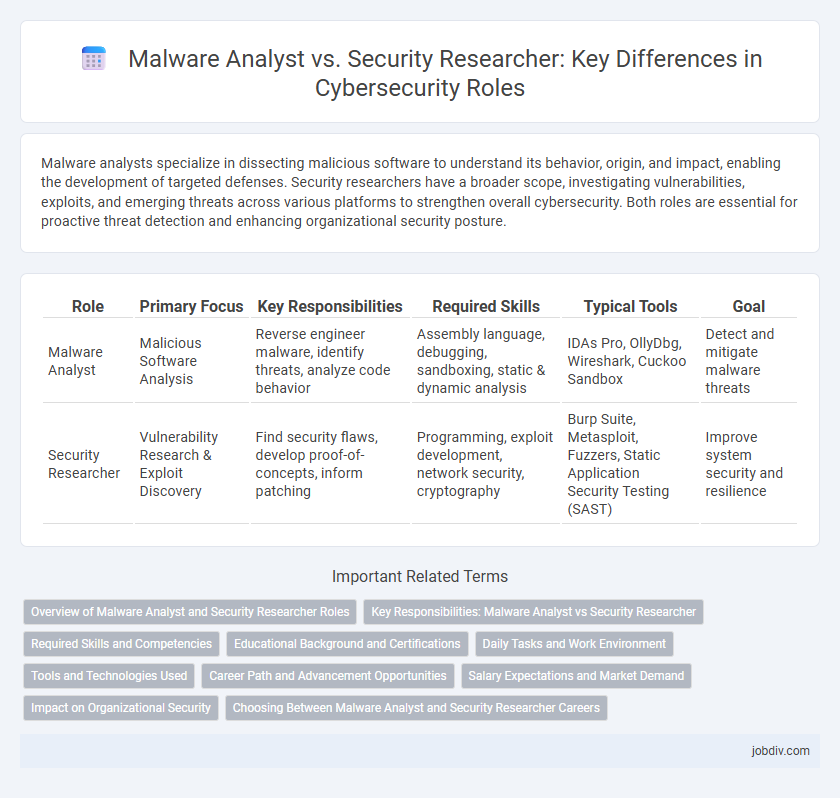Malware analysts specialize in dissecting malicious software to understand its behavior, origin, and impact, enabling the development of targeted defenses. Security researchers have a broader scope, investigating vulnerabilities, exploits, and emerging threats across various platforms to strengthen overall cybersecurity. Both roles are essential for proactive threat detection and enhancing organizational security posture.
Table of Comparison
| Role | Primary Focus | Key Responsibilities | Required Skills | Typical Tools | Goal |
|---|---|---|---|---|---|
| Malware Analyst | Malicious Software Analysis | Reverse engineer malware, identify threats, analyze code behavior | Assembly language, debugging, sandboxing, static & dynamic analysis | IDAs Pro, OllyDbg, Wireshark, Cuckoo Sandbox | Detect and mitigate malware threats |
| Security Researcher | Vulnerability Research & Exploit Discovery | Find security flaws, develop proof-of-concepts, inform patching | Programming, exploit development, network security, cryptography | Burp Suite, Metasploit, Fuzzers, Static Application Security Testing (SAST) | Improve system security and resilience |
Overview of Malware Analyst and Security Researcher Roles
Malware analysts specialize in identifying, dissecting, and understanding malicious software to develop effective detection and mitigation strategies. Security researchers focus on discovering vulnerabilities, analyzing emerging threats, and developing new security technologies or methodologies. Both roles require advanced knowledge of cybersecurity, reverse engineering, and threat intelligence, but malware analysts are more focused on practical malware dissection while security researchers emphasize theoretical and applied security innovations.
Key Responsibilities: Malware Analyst vs Security Researcher
Malware Analysts focus on identifying, dissecting, and understanding malicious software to develop detection and mitigation strategies, utilizing reverse engineering and behavioral analysis techniques. Security Researchers investigate vulnerabilities across various systems, develop security tools, and contribute to threat intelligence by analyzing emerging cyber threats and attack vectors. Both roles require deep expertise in cybersecurity, but Malware Analysts specialize in malware-specific analysis, while Security Researchers have a broader scope covering overall security landscape and innovation.
Required Skills and Competencies
Malware Analysts require expertise in reverse engineering, binary analysis, and proficiency with tools like IDA Pro and OllyDbg to dissect malicious code effectively. Security Researchers need strong skills in threat intelligence, vulnerability assessment, and programming languages such as Python and C++ to develop detection methods and security solutions. Both roles demand deep knowledge of operating systems, network protocols, and advanced analytical thinking to anticipate and mitigate cyber threats.
Educational Background and Certifications
Malware analysts typically possess a background in computer science or cybersecurity, often holding degrees that emphasize programming, reverse engineering, and threat detection, complemented by certifications such as GIAC Reverse Engineering Malware (GREM) or Certified Ethical Hacker (CEH). Security researchers generally have advanced education in computer science, information security, or related technical fields, with certifications like Offensive Security Certified Professional (OSCP) or CISSP enhancing their expertise in vulnerability research and exploit development. Both roles require continuous learning and specialized certifications to stay current with evolving cyber threats and methodologies.
Daily Tasks and Work Environment
Malware analysts primarily focus on dissecting malicious software to understand its behavior, using tools like sandbox environments and debuggers to identify threats and develop mitigation strategies. Security researchers conduct broader investigations into vulnerabilities, threat intelligence, and security trends, often publishing findings to inform the cybersecurity community and enhance defensive measures. Both roles typically operate in fast-paced, collaborative environments such as cybersecurity firms, government agencies, or enterprise security teams, requiring constant adaptation to emerging threats and technologies.
Tools and Technologies Used
Malware analysts primarily utilize sandbox environments, debuggers like OllyDbg, and disassemblers such as IDA Pro to dissect and understand malicious code behavior. Security researchers often leverage threat intelligence platforms, machine learning models, and advanced network monitoring tools like Wireshark to identify emerging vulnerabilities and attack patterns. Both roles rely on reverse engineering software and malware databases, but security researchers tend to integrate broader data analytics and automation frameworks to anticipate threats.
Career Path and Advancement Opportunities
Malware analysts specialize in identifying, dissecting, and mitigating malicious software threats, often advancing into roles like threat intelligence analyst or incident response manager. Security researchers focus on discovering vulnerabilities, developing security tools, and publishing findings, with career progression towards positions such as lead security researcher or chief security officer. Both paths offer growth through certifications like GIAC Reverse Engineering Malware (GREM) for analysts and Offensive Security Certified Professional (OSCP) for researchers, enhancing opportunities in cybersecurity leadership and strategy roles.
Salary Expectations and Market Demand
Malware analysts typically earn between $70,000 and $110,000 annually, reflecting their specialized skills in identifying and dissecting malicious software. Security researchers command higher salaries, often ranging from $90,000 to $140,000, due to their broader expertise in discovering vulnerabilities and developing security solutions. Market demand for security researchers is growing faster as organizations prioritize proactive threat identification and advanced cybersecurity measures.
Impact on Organizational Security
Malware analysts specialize in dissecting malicious software to identify attack patterns and develop mitigation strategies, directly enhancing threat detection capabilities. Security researchers investigate emerging vulnerabilities and create innovative defense mechanisms to fortify organizational systems against future cyber threats. Both roles are crucial in strengthening organizational security, with malware analysts focusing on immediate threat response and security researchers driving proactive long-term protection.
Choosing Between Malware Analyst and Security Researcher Careers
Choosing between a malware analyst and a security researcher career hinges on specialization and interest in threat detection versus broader cybersecurity innovation. Malware analysts focus on dissecting malicious software to understand attack vectors and develop mitigation strategies, using tools like sandbox environments and reverse engineering. Security researchers explore new vulnerabilities, develop defensive technologies, and contribute to security frameworks, often engaging in ethical hacking and vulnerability assessment to enhance overall cyber defense.
Malware Analyst vs Security Researcher Infographic

 jobdiv.com
jobdiv.com